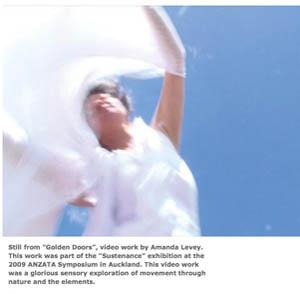Art making, whatever context it’s in, can have a very positive affect on people’s wellbeing. It can be a way of working through difficult emotions, experiences or thought-processes. It can help to centre oneself and establish a sense of inner calm. And it can allow people to communicate on a different level. Art-making can also have important therapeutic benefits for people seeking psychotherapy or counselling.
As part of Mental Health Week (9-15 October), we look at the practice and career of arts therapy.
What is Arts Therapy?
The Australian and New Zealand Arts Therapy Association (ANZATA) defines arts therapy as a form of psychotherapy that uses ‘creative modalities, including visual art-making, drama, and dance/movement to improve and inform physical, mental and emotional well-being’.
The process of creative engagement in a therapeutic relationship is believed to support changes in a person’s ‘inner world’, helping them ‘develop a more integrated sense of self, with increased self-awareness and acceptance’. It can help to improve how a person copes with stress and engages in relationships.
There’s a common misconceptions says Dr Patricia Fenner, Coordinator Graduate Diploma of Art Therapy at LaTrobe University that art therapy is a process of interpreting people’s images, much like psychiatry in the past used projective tests. ‘We don’t do that. The process of making art is as important as what is made.’
It is a very flexible form of psychological therapy, she says, that can function within a medical treatment context but also within a healing or holistic health care context.
Who does art therapy help?
Arts therapy helps people say things without saying them,’ says Dr Fenner. ‘Things that feel too threatening, at a certain point in time, can be expressed through visual means, by externalising feelings.’
Sometimes people seek arts therapy as a way of exploring questions they have about their life in the same way that someone might seek answers through other forms of counselling. It is used in a range of mental health settings, for people experiencing depression and anxiety and other major psychiatric disorders and in child, adolescent, family, trauma and palliative care counselling.
‘Art therapy is very dependent on what the person… is looking for,’ say Dr Fenner. There is not just one form of arts therapy.’ How a therapist approaches a client will depend upon their level of engagement and what they are wanting to deal with. ‘It’s a very collaborative model of working. And as such, we can be quite flexible in how, and what level of making engagement is introduced, so that it is respectful of what the person in the client role is looking for.’
Who becomes an art therapist?
Dr Fenner says her journey into arts therapy is not that uncommon. Starting as a visual artist, she went into art education and teaching before training and working in art therapy for 10 years, then entering the academic world of training and research.
The interest in entering the arts therapy profession often stems from personal experience – where someone becomes interested in how art nourishes not just aesthetically but intra-personally. ‘If you have a sensitivity to that component of the art making and art viewing process and you have an interest in well-being and the challenges that life presents to all of us, then those two things can combine to create a logical kind of outcome.’
Art therapists come from a diverse range of backgrounds. For instance, in the LaTrobe art therapy course, which is focussed on visual art, the majority of students have a visual arts background but there are also nurses, occupational therapists, psychology graduates, counsellors and people from a range of other health care professions.
There are of course, also other forms of expressive therapies too, in music, such as that offered at Melbourne University, movement and dance and drama that draw students from other arts practices.
Whatever their background, however, art-making is central to the training at LaTrobe and all applicants must present a folio of artwork. ‘We embrace the attitude that continued personal art making is important for therapeutic capacity,’ says Dr Fenner. They’re not necessarily looking for exhibiting artists but they want to see a demonstration of understanding in two dimensional and three dimensional art expression, an exploration of different materials and a capacity for expressiveness.’
What’s involved in studying Art Therapy?
There are world standard benchmarks in arts therapy training, that include a two year full time post graduate degree with at least 750 hours of clinical placement over that period. Students are required to work within interdisciplinary teams in hospital, clinical and community based settings. In Australia courses are offered through the <a program.html?acad_prog=”5151””>University of Queensland, the University of Western Sydney and LaTrobe.
Art-making is also part of the course at LaTrobe. ‘We understand the process of using art materials to be highly central in the dynamic process of art therapy, and the understanding that different materials evoke different psycho-emotional responses – it’s very experientially based training,’ says Dr Fenner.
Where does it lead?
The employment opportunities for art therapists have broadened over recent years. Some will enter private practice, however many will be employed by private psychiatric hospitals or go into public hospitals or community based health care services or psychiatric rehabilitation services. They can also become clinicians or case managers, as do many other mental health professionals.
‘Employing organisations are recognising that a student with a Master of Art Therapy has undertaken a lot of training and has a grasp of a variety of languages to work in the mental health field,’ says Dr Fenner.
For more information on finding an arts therapist or on the profession of arts therapy visit www.anzata.org or www.latrobe.edu.au
Becoming an Art Therapist
As part of Mental Health Week (9-15 October), we look at the practice and career opportunities in art therapy.
14 Oct 2011 12:00
[This is archived content and may not display in the originally intended format.]





